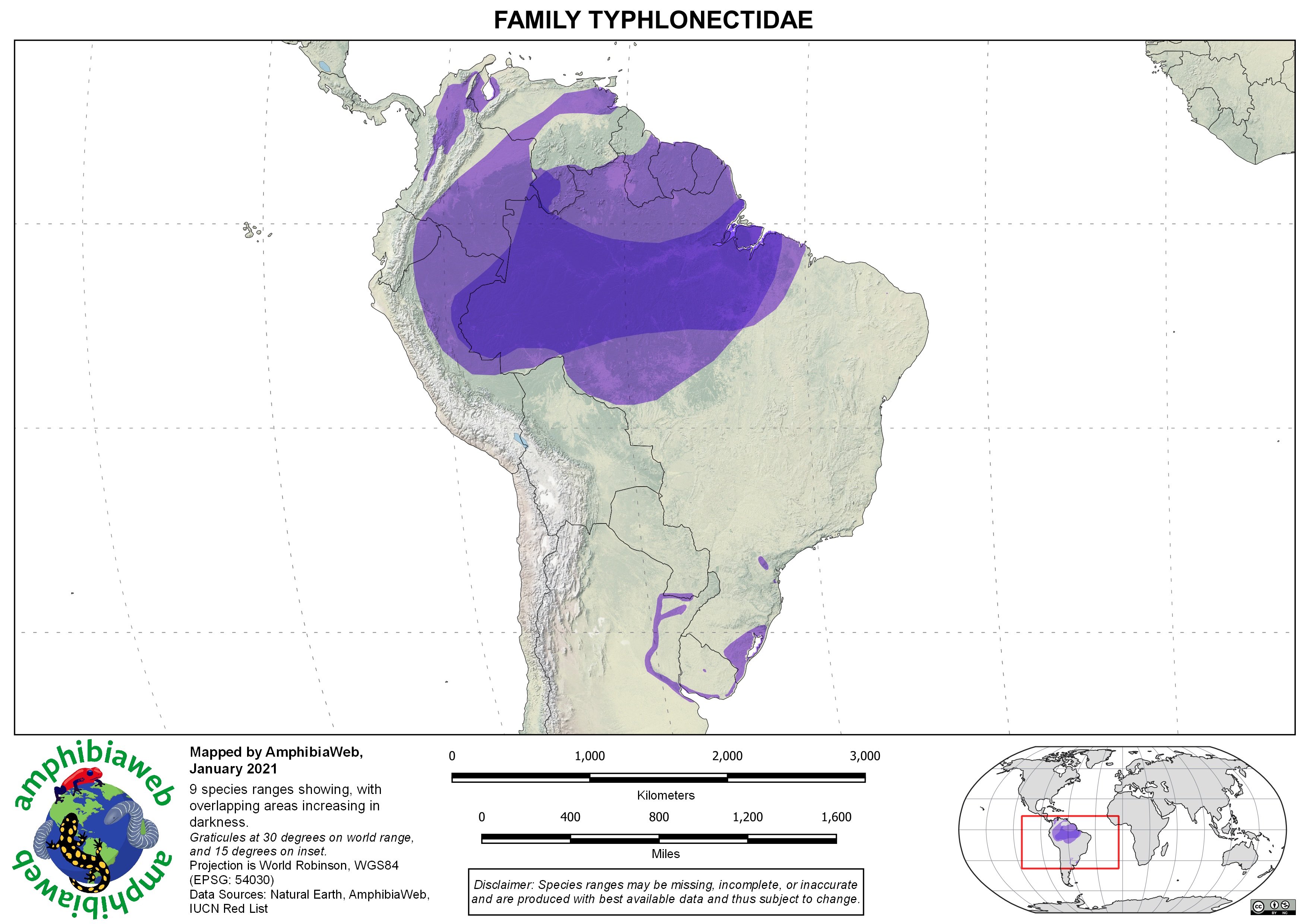Typhlonectidae |
14 species in 5 genera
Commonly Called Aquatic Caecilians
Typhlonectes compressicauda
Photo by Joachim Nerz
(Click for family gallery)Typhlonectids are unique among caecilians in that they are secondarily aquatic. Members range from 140-750 mm total length. All five genera in this family are viviparous and produce juveniles that shed their gills early on. Members may be completely aquatic or semi-aquatic; all make burrows either at water level or underwater. Fetuses feed intrauterinely throughout gestation. Typhlonectids possess tracheal lungs (an expanded trachea used as an accessory gas exchange organ) and narial plugs, secondary zygokrotaphic skulls, and lack annular scales as well as secondary annuli. One member of this family, Atretochoana eiselti, is the largest extant lungless tetrapod (reaching up to 1 meter), and is rarely seen.
This family is distributed in northern South America. The monophyly of this group is strongly supported through morphology, ecology, and geography. Typhlonectidae is the sister taxon of Caeciliidae.
News Highlight
Maciel et al. (2016) analyze relationships of the semiaquatic and aquatic South American caecilians (Typhlonectidae), including all five genera. Their integrated analysis of molecular and morphological data (including new characters) finds that while Potamotyphlus and the lungless Atretochoana share several derived characters, Potamotyphlus is the sister taxon of Typhlonectes, not of Atretochoana. Accordingly, pulmonary reduction occurred convergently in Atretochoana and Potamotyphlus. This careful and thorough study opens new avenues of research questions about the evolutionary dynamics of the clade, such as examination of the ecology and development of reduced pulmonary function. (MHWake)The caecilian fossil record is remarkably scarce. Although time-calibrated molecular phylogenies suggest that caecilians have existed for more than 200 million years, there has been named fossil referred to any of the lineages alive today (i.e., part of the crown group). Otávio Santos and colleagues (2024) have described a new extinct caecilian, Ymboirana acrux, from the Oligocene (approximately 25 million years ago) of Brazil and that they refer to the living family Typhlonectidae. This extinct caecilian was likely aquatic and was fossilized in what was then a lake. The remarkable preservation of both its vertebral column and much of its skull promises that this fossil will be an important resource for understanding the evolution of caecilians in South America. (DCBlackburn)
Written by AmphibiaWebNotable Family Characteristics
- Aquatic and Semi-aquatic
- Tropical and temperate forests
- Viviparous
- Morphological features include: 1) tracheal lungs and narial plugs; 2) secondary zygokrotaphic skulls; 3) lack annular scales as well as secondary annuli
- Fully aquatic species (Typhlonectes) have compressed bodies and dorsal fins
- Distribution limited to northern South America

Cartography Credit: Zoe Yoo, UC Berkeley
Range maps sources: AmphibiaWeb, UC Berkeley, and IUCN RedListRelevant Reference
Maciel, A. O., Sampaio, M. I. C., Hoogmoed, M. S., Schneider, H. 2017. Phylogenetic relationships of the largest lungless tetrapod (Gymnophiona, Atretochoana) and the evolution of lunglessness in caecilians. Zoologica Scripta (46) 255–263.
Pough, F. H., R. M. Andrews, M. L. Crump, A. H. Savitzky, K. D. Wells, and M. C. Brandley. 2015. Herpetology. Fourth Edition. Massachusetts: Sinauer.
Vitt, L. J., and J. P. Caldwell. 2013. Herpetology. An Introductory Biology of Amphibians and Reptiles. Fourth Edition. Amsterdam: Elsevier.
Genus Atretochoana (1 species)
Atretochoana eiselti account photos no sound/video
Genus Chthonerpeton (9 species)
Chthonerpeton arii no account no photos no sound/video Chthonerpeton braestrupi no account no photos no sound/video Chthonerpeton exile no account no photos no sound/video Chthonerpeton indistinctum account photos no sound/video Chthonerpeton noctinectes no account no photos no sound/video Chthonerpeton onorei no account no photos no sound/video Chthonerpeton perissodus no account no photos no sound/video Chthonerpeton tremembe no account no photos no sound/video Chthonerpeton viviparum no account no photos no sound/video
Genus Nectocaecilia (1 species)
Nectocaecilia petersii account no photos no sound/video
Genus Potomotyphlus (1 species)
Potomotyphlus kaupii account photos no sound/video
Genus Typhlonectes (2 species)
Typhlonectes compressicauda account photos no sound/video Typhlonectes natans account photos no sound/video

